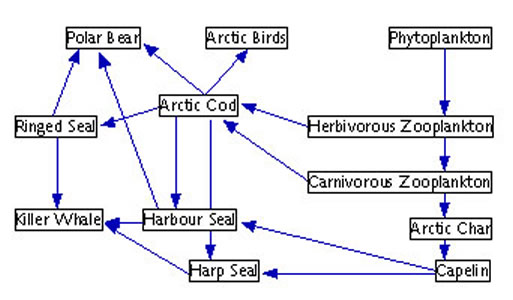Earths Spheres, Ecosystems and Protected Spaces
Ecosystems and Interactions
MINDS ON
One Small Change
How can one change in an ecosystem affect the species living within that environment? Let’s see how a deer population could be affected by changes that we often see occur in Canada.
DeerGame
ACTION
What is an ecosystem?
As you likely already know an ecosystem is a community of living things interacting with one another in a physical environment. Healthy ecosystems are the key to the survival of all living things on this planet!
Check out this short video which highlights some of the important topics you will learn about in this activity, including biotic and abiotic factors and food webs.
Abiotic and Biotic Factors
Biotic and abiotic factors are the different elements that play a role in influencing an ecosystem. A biotic factor (definition:This is any living component that affects the organisms within the ecosystem. Examples: decomposers, herbivores, etc.) is any living component that affects the organisms within the ecosystem. An abiotic factor (definition:This is a non-living condition that affects the ecosystem. Examples: sunlight, precipitation, etc.) is a non-living condition that affects the ecosystem.
AboutBioticAbioticFactors
Abiotic and biotic factors combine to play an important role in providing the ideal living conditions for an ecosystem to thrive. Before we move on, let’s check your understanding of the abiotic and biotic factors involved in ecosystems.
BioticAbioticDD
Case Study: The Arctic
We know that both biotic and abiotic factors influence the health of an ecosystem, but how are they all interconnected? Let’s take a look at one specific area of the world, the Arctic, and see how these factors influence the stability of the ecosystem.
Check out this short video to learn about life below the ice in the Arctic. As you watch the video be sure to consider all the biotic and abiotic factors that come together to form all the pieces of the Arctic puzzle.
A food web is similar to a food chain, with the addition of many more interconnections. It’s not a linear chain; it’s a web that demonstrates all the intersecting food chains and represents the different things that an organism can eat and be eaten by. Much like a delicate spider web, if one part of the food web is removed it can affect the whole web.
In a food web, the arrows point from the organism that is eaten to the organism that eats it.
Check out this example for an Arctic food web:

 Arctic Food Web
Arctic Food Web
Using the short video you watched, the food web, as well as any other additional research you choose to do, how do you think changes in biotic and abiotic factors could influence the Arctic food web? How would this affect Inuit who rely on this food web? Challenge yourself to come up with as many as possible. Record your findings by writing them down, or recording a short video.
CONSOLIDATION
Each of us lives in a specific ecosystem that has its own unique characteristics. It’s time to take a closer look and investigate our local ecosystems. Whether you live in a highly populated urban area or a remote rural community, you are surrounded by organisms that are interconnected and influenced by both biotic and abiotic factors.
 My Local Ecosystem
My Local Ecosystem
Your challenge is to create a food web that represents an ecosystem in your local community and discuss the biotic and abiotic factors that influence this system. You may create your food web and explanation in any format you choose. It could be a video, a prezi, a digital document, or a paper copy.
Step 1: Find an ecosystem where you live. This could be a fallen log, a forest, a pond, a small stand of trees, your backyard, etc. Take a photograph of your chosen ecosystem. What are the various biotic and abiotic components in your ecosystem? You may have to do some additional research on your ecosystem.
Step 2: Identify all the connections between the organisms in your ecosystem. Include human connections where applicable. How do they each rely on each other? Use arrows like the example you saw in the Arctic food web. Reminder: In a food web, the arrows point from the organism that is eaten to the organism that eats it.
Step 3: Identify and explain a minimum of three potential changes to your food web based on biotic or abiotic factors. Example: How could climate change affect your ecosystem’s food web?
Step 4: Complete this self-assessment checklist.
Self-Assessment Checklist
| Yes/No | Tasks |
|---|---|
|
I have included a photograph of my chosen ecosystem. |
|
|
I have identified abiotic and biotic factors that make up my local ecosystem. |
|
|
I have explained how these interconnections between organisms contribute to my ecosystem’s ability to withstand change (stability). |
|
|
I have identified and predicted how different biotic and abiotic factors contribute to my ecosystem’s health and stability. |
|
|
I have created a food web that shows the ecosystem that exists where I live. |